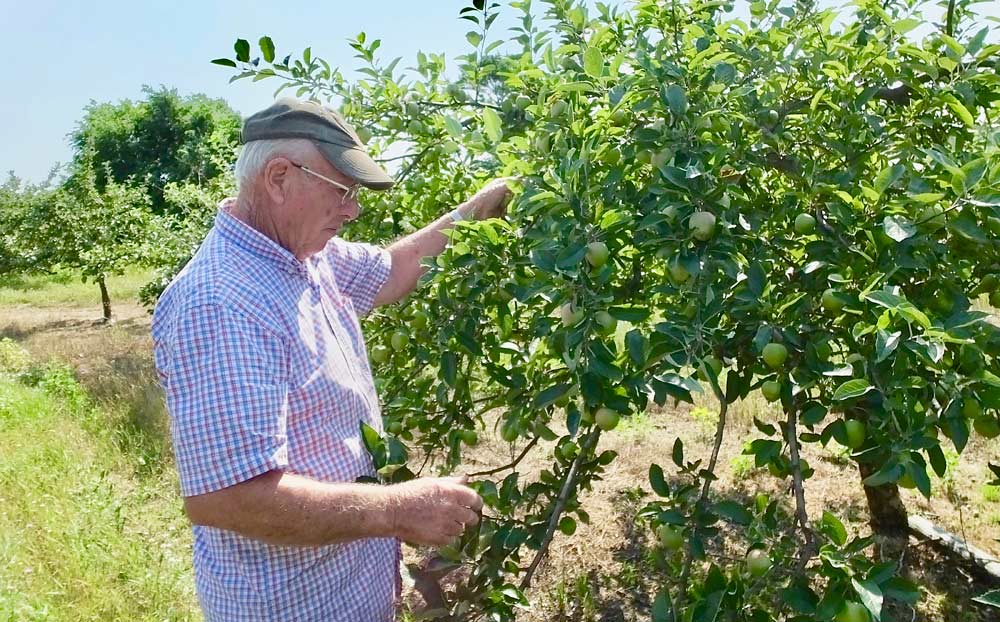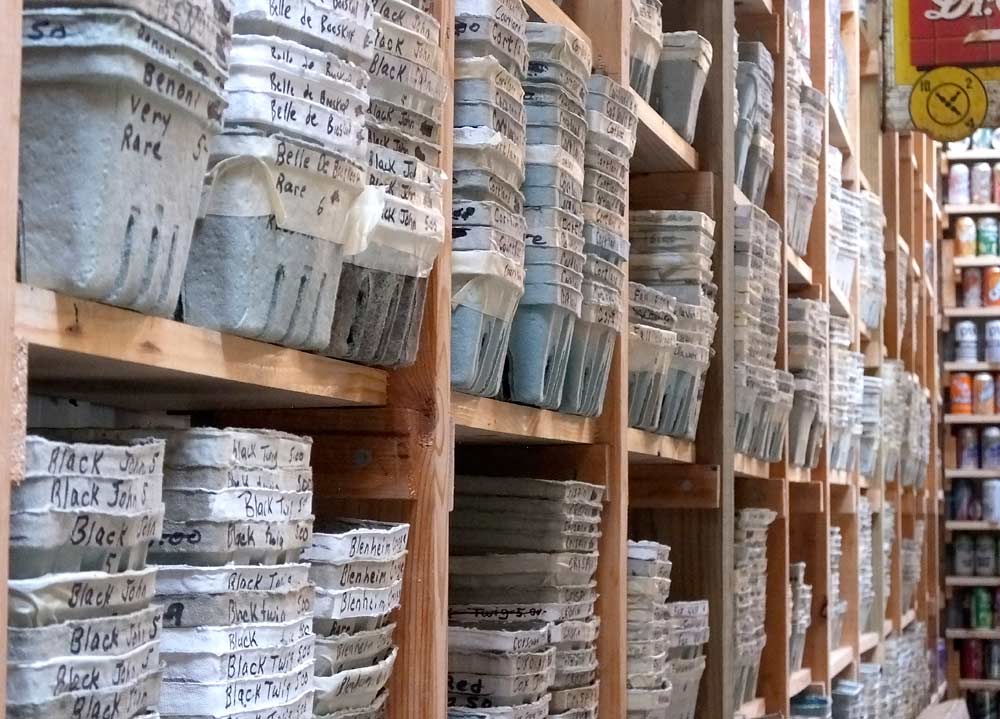
As he walks down rows of vintage apples, John Kilcherman constantly stops to thin. Here, he plucks off a few Swiss Gourmet or Arlet, a cross between Golden Delicious and Idared that was developed in Switzerland. (Photo by Leslie Mertz)
Grower John Kilcherman is a collector. His barn walls are lined with 10,000-plus soda-pop bottles in what he claims is the world’s largest assortment, he has a library of historical fruit books dating back to the 1600s, and he has some 300 cruets on display.
But what really turns the heads of apple aficionados is Kilcherman’s Christmas Cove Farm, where he and his wife, Phyllis, grow more than 200 varieties on their 82 acres in Michigan’s northwestern Lower Peninsula. Many are antique apples heralding from Europe and Colonial America, and others are unique fruits selected for shape, size, flavor or other unusual characteristics.
The story behind the Kilchermans’ orchard begins in 1930, when John was born on the family farm just a half-mile from where he lives now. As he grew up, he and some neighbor boys played ball among the few apple trees that his father and grandfather had planted for family use.
“A lot of the trees were getting old by then, and some of them were dead, so if a tree was missing, there’d be a pit that we would use as a pitcher’s mound, and if another tree was missing, we’d use that as home plate.
Then we’d run to the Wealthy tree (which served as) first base, the Snow Apple as second base, and the Winter Banana tree as third base,” he said.
Once he matured a bit, he thought about those vintage apple trees as something more than bases. “I said to myself, ‘I’m going to plant some of these old varieties just to see what they really are like,’” he said.
And that’s what he did … eventually.
Phyllis and John married in 1952, and with some help from their parents, bought a down-on-its-luck farm in 1955.
To make ends meet while getting the farm up and running, he worked different farm jobs for the neighbors, then took a job at a nearby canning factory (eventually becoming warehouse foreman), and spent many years as head custodian at a school. All the while, he and Phyllis were working on the farm, planting, tending and harvesting strawberries, cherries and commercial apples.
John never forgot the old trees in his family’s orchard, and in 1975 he began to seek out and plant heritage varieties here and there along the fencerow and in other spots where they wouldn’t interfere with his operation financially.
“Once we started getting some of these apples, my wife came up with the idea of making gift boxes of these old varieties of apples. So we put 12 apples in a box or 16 apples in a box, and we started doing a mail-order business,” he said. With each apple in the gift box, they included a card that provided a few facts about the apple, including where and when it originated.

When the apples come in and these rows upon rows of baskets are filled with the 200-plus varieties of antique and rare apples, John Kilcherman says the display is “like a museum in a sense.” (Photo by Leslie Mertz)
The gift boxes were “a big hit,” Phyllis said. They continued the mail-order business for about 20 years — until mailing costs became prohibitively expensive — and now sell their apples at a very busy roadside stand in front of their house. The Kilchermans’ children and grandchildren all chip in, especially during harvest time, she said. “It has turned out to be a really fun thing in our lives.”
Any leftover historic apples go to a local cider mill, Tandem Ciders, which makes a unique hard cider called Pretty Penny.
Just as the apple trees originate far and wide, so do their customers. “We’ve met so many people from around the world that you can’t believe it,” John said. “We’ve had people parking a quarter-mile down the road,” he said. “People are just so happy to get these apples so they can try them. It’s like a new adventure.”
For the Kilcherman family, the vintage orchard has also been a grand and wonderful undertaking. Nodding his head and smiling at Phyllis, John said, “It’s certainly made life more interesting for us. That’s for sure.” •
by Leslie Mertz
Heritage varieties
When asked about their favorite apples on the farm, John and Phyllis Kilcherman play off one another while quickly naming dozens. Here are a few of their top picks:
—The very rare Kandil Sinap originated a couple of centuries ago on the Crimean Peninsula.
—Winter Banana has a touch of the tropical fruit’s flavor. (Phyllis maintains that the flavor is obvious. John says a good imagination helps.)
—Opalescent has a shimmering, waxy skin and low-sugar attributes.
—The sweet, late-season Ingrid Marie is from Denmark.
—Hawaii has notes of pineapple.
—The spicy Spitzenburg was supposedly prized by Thomas Jefferson.
—The citrus-flavored Cox’s Orange Pippin is from 1850s England.
—The most ancient apple at the orchard is the Lady Apple, also known as the Christmas apple, a small but exceptionally tasty fruit that “dates back to the time of Christ and the Roman Empire,” Phyllis said.
—The most popular, however, is the Macoun, which Phyllis described as a cross between McIntosh and Arkansas Black. “Because of the Arkansas Black, it’s crisp, so when you bite into it, it just snaps. And with the McIntosh parent, you get that Mac flavor,” she said. “We have Honeycrisp too, but Macoun sells faster than Honeycrisp. It’s just an excellent multipurpose apple.”
More information about their wide assortment of varieties, as well as Phyllis’ favorite apple recipes, are available in their book Antique Apples from Kilcherman’s Christmas Cove Farm, which was published in 2016.
by Leslie Mertz






Leave A Comment